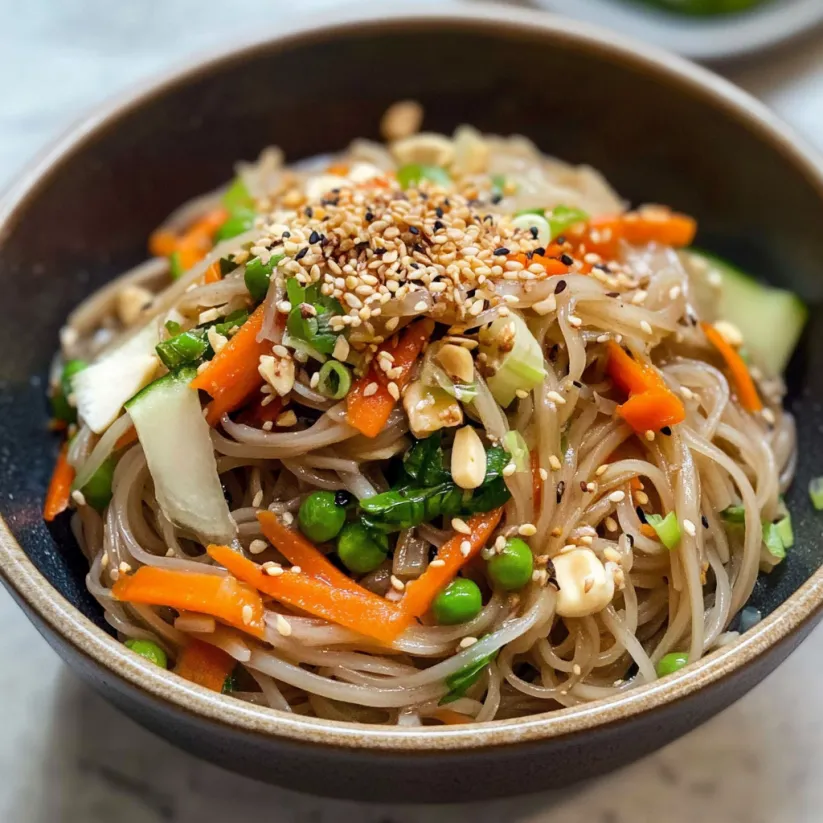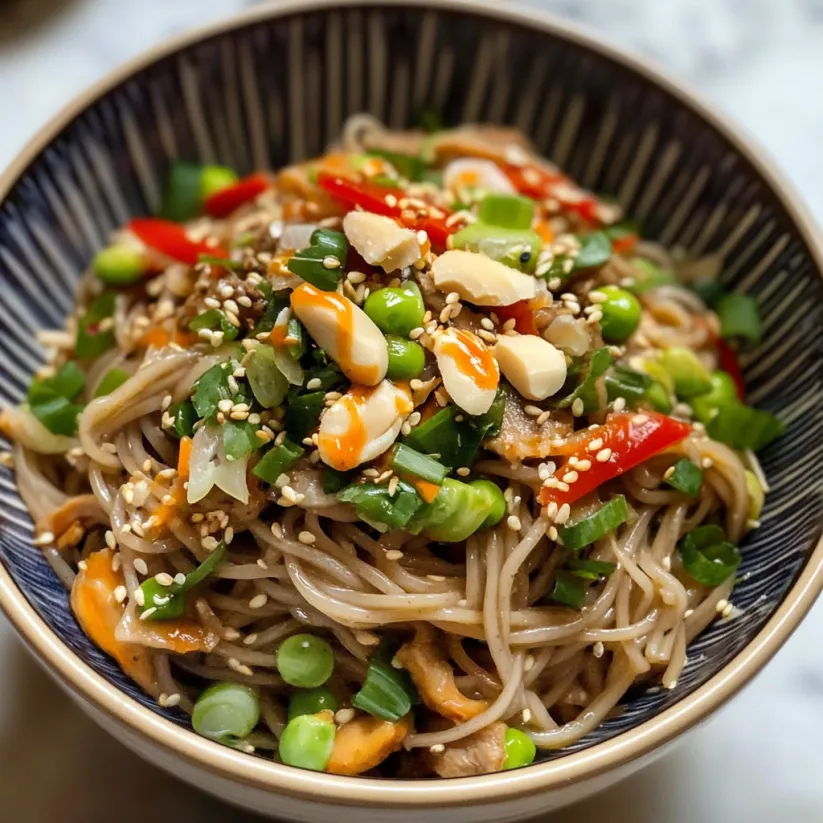 Save Pin
Save Pin
This simple cold buckwheat noodle dish has become my summer dinner savior when temperatures soar and cooking feels impossible. The combination of chewy soba noodles with a umami-rich miso dressing creates a refreshing meal that satisfies without weighing you down.
I first created this recipe during a particularly brutal heatwave when turning on the stove seemed criminal. Now it's in regular rotation at our house from spring through fall, especially for quick weeknight dinners when time is short.
Ingredients
- 8 oz dried soba noodles: the backbone of this dish providing satisfying chew and nutty flavor
- 1 cup shelled edamame: adding plant protein and bright color
- 1 cup thinly sliced carrots: for sweetness and crunch
- 1 1/2 cup bean sprouts: providing freshness and texture contrast
- 1/4 cup roughly chopped mint leaves: adds cooling brightness
- 1/4 cup roughly chopped cilantro leaves: for herbal complexity
- 1/4 cup crushed cashews: delivering richness and protein
- 4 tbsp miso paste: creates the umami foundation for the dressing
- 2 tbsp rice vinegar: brings necessary acidity
- 1.5 tbsp maple syrup: balances the saltiness with gentle sweetness
- 1 tbsp chili garlic sauce: adds customizable heat
- 1 tsp sesame oil: provides nutty depth
- 2 tsp soy sauce: enhances the savory notes
- 2 tbsp water: thins the dressing to perfect consistency
Step-by-Step Instructions
- Boil Water:
- Fill a large pot with water and bring to a rolling boil for the soba noodles. If using frozen edamame, start a second smaller pot of water or prepare according to package instructions. The key is timing everything to come together at once.
- Mix Miso Dressing:
- While waiting for water to boil, combine all dressing ingredients in a small bowl. Whisk thoroughly until the miso paste completely dissolves and no lumps remain. The dressing should be smooth but still have some body. Taste and adjust seasonings if needed.
- Cook Noodles:
- Add soba noodles to boiling water and cook according to package directions, usually about 4 minutes. Do not overcook as they can quickly become mushy. Immediately drain in a colander and rinse thoroughly under cold running water while gently separating the strands with your fingers.
- Prepare Remaining Ingredients:
- While noodles cook, prep your vegetables if not already done. Slice carrots very thinly for best texture. Cook edamame according to package directions until bright green and tender, about 3 minutes. Rinse under cold water to stop cooking.
- Mix Salad:
- In a large serving bowl, combine the cold noodles, carrots, bean sprouts, mint, cilantro, and edamame. Pour the miso dressing over everything and toss gently but thoroughly with tongs until all components are evenly coated with dressing.
- Serve:
- Transfer to individual bowls and top with crushed cashews. For extra visual appeal and flavor, consider adding a sprinkle of sesame seeds and sliced spring onions if desired.
 Save Pin
Save Pin
The miso paste is truly the heart of this recipe. I once tried substituting it with other ingredients, and the dish lost its soul completely. I discovered that the white miso variety works wonderfully for those new to miso because of its milder, sweeter profile compared to red or brown varieties.
Make It Your Own
This recipe welcomes personal touches. Try adding thinly sliced red bell peppers for color and vitamin C, or throw in some avocado chunks just before serving for creaminess. Thinly sliced cucumber adds refreshing crunch, while a handful of baby spinach boosts the nutrition even further. The noodle base remains delicious with nearly any vegetable addition.
 Save Pin
Save Pin
Serving Suggestions
While perfect on its own as a light meal, these noodles also pair wonderfully with grilled tofu or tempeh for additional protein. They make an excellent side dish for Asian-inspired grilled vegetables or plant-based dumplings. I love serving this at outdoor gatherings since it can sit at room temperature safely and actually tastes better as the flavors meld.
Cultural Context
Soba noodles have been a staple in Japanese cuisine for centuries, prized for their nutty flavor and nutritional benefits. Traditionally served either hot in broth or cold with dipping sauce, this recipe takes inspiration from Japanese zaru soba while incorporating pan-Asian ingredients. The inclusion of miso creates depth while edamame adds protein traditionally found in accompanying dishes.
Storage Tips
The noodles will absorb more of the dressing as they sit, so you might want to reserve a small portion of dressing to refresh leftovers. Store in an airtight container in the refrigerator for up to five days. The dish actually improves somewhat after a day as flavors meld together, making it perfect for make-ahead meals.
Commonly Asked Questions
- → Can I make this buckwheat noodle dish ahead of time?
Yes, this dish stores excellently in an airtight container in the refrigerator for up to 5 days. The flavors actually develop and improve over time, making it perfect for meal prep. You can serve it chilled straight from the fridge or allow it to come to room temperature.
- → What can I substitute for soba noodles?
If soba noodles aren't available, you can substitute with rice noodles, whole wheat spaghetti, or even zucchini noodles for a lower-carb option. Each alternative will provide a different texture, but the dish will still be delicious with the miso dressing.
- → Is this dish gluten-free?
Traditional soba noodles contain some wheat flour along with buckwheat. For a gluten-free version, look for 100% buckwheat soba noodles and make sure to use gluten-free soy sauce and miso paste (some varieties contain wheat).
- → What protein can I add to make this a complete meal?
While this dish already contains plant-based protein from edamame and cashews, you could add tofu, tempeh, or seitan for vegan options. Non-vegetarians might enjoy adding shredded chicken, sliced beef, or shrimp for additional protein.
- → Can I adjust the spiciness of the miso dressing?
Absolutely! The spice level comes from the chili garlic sauce (sambal oelek or sriracha). You can reduce the amount for a milder flavor or increase it if you prefer more heat. Start with half the recommended amount if you're sensitive to spice and adjust to taste.
- → What vegetables work well as substitutions in this dish?
This versatile dish works well with many vegetables. Try thinly sliced bell peppers, cucumber, radishes, snap peas, or shredded cabbage. Avocado adds creaminess, while pickled vegetables can add an interesting tangy contrast to the miso dressing.
